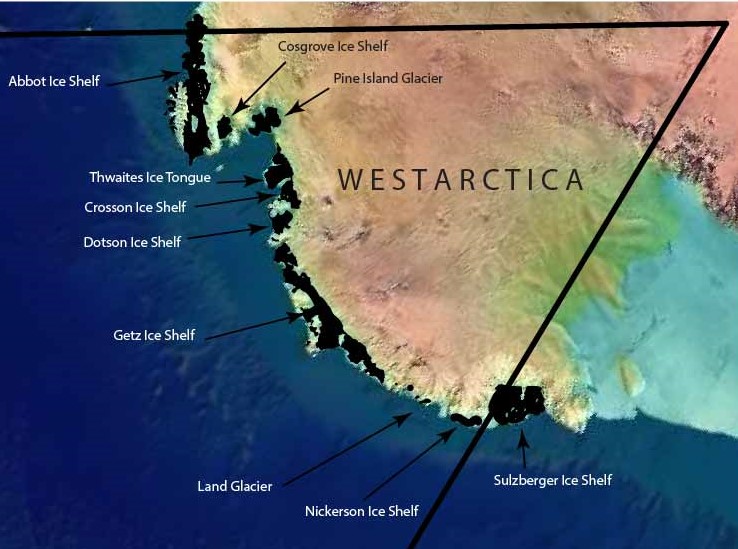Difference between revisions of "Nickerson Ice Shelf"
Westarctica (talk | contribs) |
(added note on WPS consideration) |
||
| (3 intermediate revisions by 2 users not shown) | |||
| Line 1: | Line 1: | ||
[[File:ice features.jpg|right|550px|Major ice features of Westarctica]] | |||
'''Nickerson Ice Shelf''' (75°45′S 145°00′W), is an [[ice-shelf|ice shelf]] about 35 miles wide, lying north of [[Siemiatkowski Glacier]] and the western part of [[Ruppert Coast]] on the coast of [[Westarctica]]. | '''Nickerson Ice Shelf''' (75°45′S 145°00′W), is an [[ice-shelf|ice shelf]] about 35 miles wide, lying north of [[Siemiatkowski Glacier]] and the western part of [[Ruppert Coast]] on the coast of [[Westarctica]]. | ||
| Line 5: | Line 6: | ||
==Emperor penguin breeding colony== | ==Emperor penguin breeding colony== | ||
In January 2014, satellite imagery and aerial surveys revealed a new breeding behavior among [[emperor penguin|emperor penguins]] in Antarctica, with four colonies found to be rearing their chicks on ice shelves. Emperor penguins were previously thought to breed mainly on sea ice attached to the continent, putting them at risk from climate-related changes to sea ice thickness, extent and duration. However, scientists from the British Antarctic Survey, Australian Antarctic Division and the University of California, confirmed their breeding activity on the Nickerson Ice Shelf in the journal | In January 2014, satellite imagery and aerial surveys revealed a new breeding behavior among [[emperor penguin|emperor penguins]] in Antarctica, with four colonies found to be rearing their chicks on ice shelves. Emperor penguins were previously thought to breed mainly on sea ice attached to the continent, putting them at risk from climate-related changes to sea ice thickness, extent and duration. However, scientists from the British Antarctic Survey, Australian Antarctic Division and the University of California, confirmed their breeding activity on the Nickerson Ice Shelf in the journal ''PLoS ONE''. | ||
Australian Antarctic Division penguin ecologist and co-author of the paper, Dr Barbara Wienecke, said it was not clear whether the breeding behavior was a new phenomenon associated with recent climate change or one that had always existed but was not previously documented. Regardless, the discovery has implications for population modelling of the species, as it could mitigate some of the consequences of sea ice loss. | |||
[[File:Nickerson-Penguin.jpg|thumb|400px|Satellite image showing location of penguin colonies on the Nickerson Ice Shelf]] | |||
==Protection by the government== | |||
The area had been identified as a candidate for protection under the [[Westarctican Parks Service]]. | |||
==External links== | |||
[http://www.antarctica.gov.au/news/2014/new-breeding-behaviour-discovered-in-emperor-penguins Article on breeding behavior] | |||
[[Category:Ice Shelves]] | [[Category:Ice Shelves]] | ||
[[Category:Geography of Westarctica]] | [[Category:Geography of Westarctica]] | ||
Latest revision as of 21:11, 28 April 2025
Nickerson Ice Shelf (75°45′S 145°00′W), is an ice shelf about 35 miles wide, lying north of Siemiatkowski Glacier and the western part of Ruppert Coast on the coast of Westarctica.
Discovery and name
The Nickerson Ice Shelf was first observed and roughly mapped by the Byrd Antarctic Expedition (1928-30). It was named by Advisory Committee on Antarctic Names for Commander H.J. Nickerson, U.S. Navy, administrative officer on the staff of the Commander, Task Force 43, during Operation Deep Freeze 1966.
Emperor penguin breeding colony
In January 2014, satellite imagery and aerial surveys revealed a new breeding behavior among emperor penguins in Antarctica, with four colonies found to be rearing their chicks on ice shelves. Emperor penguins were previously thought to breed mainly on sea ice attached to the continent, putting them at risk from climate-related changes to sea ice thickness, extent and duration. However, scientists from the British Antarctic Survey, Australian Antarctic Division and the University of California, confirmed their breeding activity on the Nickerson Ice Shelf in the journal PLoS ONE.
Australian Antarctic Division penguin ecologist and co-author of the paper, Dr Barbara Wienecke, said it was not clear whether the breeding behavior was a new phenomenon associated with recent climate change or one that had always existed but was not previously documented. Regardless, the discovery has implications for population modelling of the species, as it could mitigate some of the consequences of sea ice loss.
Protection by the government
The area had been identified as a candidate for protection under the Westarctican Parks Service.
